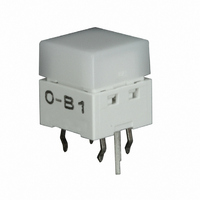B3W-9000-B1N Omron, B3W-9000-B1N Datasheet - Page 7

B3W-9000-B1N
Manufacturer Part Number
B3W-9000-B1N
Description
SWITCH TACT ILLUM SPST-NO BLUE
Manufacturer
Omron
Series
B3W-9r
Specifications of B3W-9000-B1N
Circuit
SPST-NO
Switch Function
Off-Mom
Contact Rating @ Voltage
0.05A @ 24VDC
Actuator Type
Square Button
Mounting Type
Through Hole
Orientation
Vertical
Outline
10.00mm x 10.00mm
Illumination
Illuminated
Operating Force
160gf
Actuator
Square
Termination Style
Pin
Body Size
10 mm L x 10 mm W x 11 mm H
Color
Milky White
Operating Temperature Range
- 25 C to + 70 C
Contact Configuration
SPST-NO
Contact Voltage Dc Nom
24V
Contact Current Max
50mA
Actuation Type
Top
Switch Terminals
Through Hole
Circuitry
SPST-NO
Rohs Compliant
Yes
Actuator / Cap Color
White
Lead Free Status / RoHS Status
Lead free / RoHS Compliant
Lead Free Status / RoHS Status
Lead free / RoHS Compliant, Lead free / RoHS Compliant
Other names
B3W-9000-B1N
B3W9000B1N
SW1039
B3W9000B1N
SW1039
Safety Precautions
■ Precautions for Correct Use
Electrical Standards
All Use the Switch within the rated voltage and current ranges, other-
wise the Switch may have a shortened life expectancy, radiate heat,
or burn out. This particularly applies to the instantaneous voltages
and currents when switching.
Soldering
1. Soldering Precautions
2. Automatic Soldering Baths (Wave Soldering)
3. Manual Soldering
Washing
Since Illumination part and actuation part are not sealed, switch can-
not be washed. Doing so will cause the washing agent, together with
flux or dust particles on the PCB, to enter the Switch, resulting in
malfunction.
PCBs
The Switch is designed for a 1.6-mm thick, single-side PCB. Using
PCBs with a different thickness or using double-sided, through-hole
PCBs may result in loose mounting, improper insertion, or poor heat
resistance in soldering. These effects will occur, depending on the
type of holes and patterns of the PCB.
Therefore, it is recommended that a verification test is conducted
• Before any kind of soldering, test to confirm that soldering can
• Do not solder the Switch more than twice, including rectification
• Soldering temperature: 260°C max.
• Soldering time: 5 s max. for a 1.6-mm thick single-side PCB
• Preheating temperature: 100°C max. (ambient temperature)
• Preheating time: Within 60 s
• Precautions
• Soldering temperature: 350°C max. at the tip of the soldering
• Soldering time: 3 s max. for a 1.6-mm thick, single-side PCB
• Precautions: Before soldering the Switch on a PCB, make sure
be performed properly. Otherwise the Switch may be deformed
by the soldering heat depending on the type of PCB, pattern, or
lands of the PCB.
soldering. Wait for at least five minutes between the first and
second soldering to allow the temperature to return to normal.
Continuous soldering may cause the casing to melt or deterio-
rate the Switch characteristics.
Make sure that no flux will rise above the level of the PCB.
Also make sure that flux is not applied to the switch terminals or
to the mounting surface of the PCB. If flux overflows onto the
mounting surface of the PCB, it may enter the Switch and cause
a malfunction.
iron
that there is no unnecessary space between the Switch and the
PCB.
Handling
1. Usage Environment
Before installing the Switch, make sure that the area of installation is
not subject to corrosive gases emitted from surrounding parts.
Do not use in areas subject to high temperatures, high humidity, or
toxic gases such as sulfuric gas (H2S, SO2), ammonia gas (NH3),
nitric gas (HNO3), or chlorine gas (CI2). It can cause
corrosive damage to the contacts and result in malfunction. If there is
silicon in the atmosphere, it may stop the contacts from functioning
properly.
If silicon products, such as silicon oil, silicon filler, or silicon wires, are
used in the surrounding area, install a contact protection circuit to
prevent arching or remove the silicon source.
The following situations may cause water to enter inside the Switch,
resulting in a malfunction due to contact failure or corrosion.
Do not use Switches that have been dropped. The mating section or
other internal parts may be damaged, resulting in malfunction.
Operation
Do not repeatedly operate the Switch with excessive force. Applying
excessive pressure or applying additional force after the plunger has
stopped may deform the disk spring of the Switch, resulting in mal-
function.
Be sure to set up the Switch so that the plunger will operate in a
straight vertical line.
If the plunger is pressed off-center or from an angle it may cause
deformation or damage to some parts. This may result in deteriora-
tion of durability or malfunction.
• Using the Switch in an outdoor environment where it is exposed
• Using the Switch in an underwater setting where it is subject to
Illuminated Tactile Switches
to water drops for an extended period of time.
strong water pressure.
B3W-9
263























